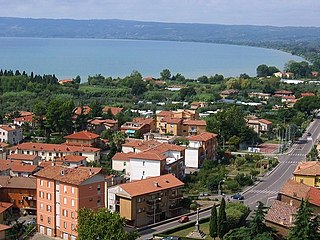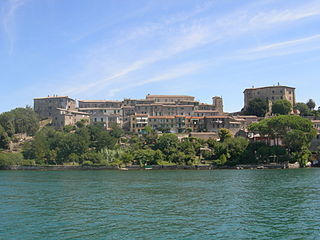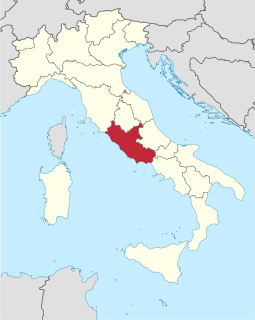This page is based on this
Wikipedia article Text is available under the
CC BY-SA 4.0 license; additional terms may apply.
Images, videos and audio are available under their respective licenses.

Volsinii or Vulsinii, is the name of two ancient cities of Etruria, one situated on the shore of Lacus Volsiniensis, and the other on the Via Clodia, between Clusium (Chiusi) and Forum Cassii (Vetralla). The latter was Etruscan and was destroyed by the Romans in 264 BC following an attempted revolt by its slaves, while the former was founded by the Romans using the remainder of the Etruscan population rescued from the razed city.

Latera is a small town and comune in the Province of Viterbo, Italy.
Situated near Bolsena Lake and Mezzano Lake, is important for volcanic underground activity near the town centre. It has a small rock with a medieval palace by Farnese family, surrounded by medieval stone houses.

Montefiascone is a town and comune of the province of Viterbo, in Lazio, central Italy. It stands on a hill on the southeast side of Lake Bolsena, about 100 km (60 mi) north of Rome.

San Lorenzo Nuovo is a small town and comune in the province of Viterbo, in the Latium region of Italy. It is an agricultural center producing potatoes, olive oil, garlic, onions, cereals and grapes. A second source of revenue is tourism.

Capodimonte is a comune (municipality) in the Province of Viterbo in the Italian region Lazio, located about 90 kilometres (56 mi) northwest of Rome and about 20 kilometres (12 mi) northwest of Viterbo. It is on the southwestern shore of Lake Bolsena. In contrast to the other communities on the lake, Capodimonte has a headland with a sheltered harbor.

Gradoli is a comune (municipality) in the Province of Viterbo in the Italian region Latium, located about 100 kilometres (62 mi) northwest of Rome and about 35 kilometres (22 mi) northwest of Viterbo.

Marta is a comune (municipality) in the Province of Viterbo in the Italian region Latium, located about 80 kilometres (50 mi) northwest of Rome and about 20 kilometres (12 mi) northwest of Viterbo.

The Mass at Bolsena is a painting by the Italian renaissance artist Raphael. It was painted between 1512 and 1514 as part of Raphael's commission to decorate with frescoes the rooms that are now known as the Raphael Rooms, in the Apostolic Palace in the Vatican. It is located in the Stanza di Eliodoro, which is named after The Expulsion of Heliodorus from the Temple.
The Fanum Voltumnae was the chief sanctuary of the Etruscans; fanum means a sacred place, a much broader notion than a single temple. Numerous sources refer to a league of the “Twelve Peoples” (lucumonies) of Etruria, formed for religious purposes but evidently having some political functions. The Etruscan league of twelve city-states met annually at the Fanum, located in a place chosen as omphalos, the geographical and spiritual centre of the whole Etruscan nation. Each spring political and religious leaders from the cities would meet to discuss military campaigns and civic affairs and pray to their common gods. Chief amongst these was Voltumna, possibly state god of the Etruria.

The Monti Volsini or Vulsini are a minor mountain range in northern Lazio, Italy, near the Lake Bolsena. The highest point is that of Passo della Montagnola, in the comune of Latera, at c. 645 m.

Vulsini, also known as Volsini volcano, Vulsini Volcanic District, Vulsini Volcanic Complex and the Vulsinian District, is a circular region of intrusive igneous rock in Lazio, Italy, about 87 km (54 mi) to the north northwest of Rome, containing a cluster of calderas known to have been active in recent geologic and historical times. Potentially they still are active. The Vulsinian region is one of dozens of intrusive circular regions, most smaller than the Vulsinian, arranged in a band from Campania through Lazio, called the Roman Comagmatic Province. A comagmatic province is a geologic area of the same type and age igneous rock deriving from the same crustal magma. The Roman region is post-collisional; that is, the intrusions were not a result of the lateral stresses that created Italy and raised the Apennines, but were subsequent to Italy's creation. The Volsinian is the northernmost region.
Volsinii, Volsini or Vulsini can refer to the following items:

Saint Christina of Bolsena, also known as Christina of Tyre, or in the Eastern Orthodox Church as Christina the Great Martyr, is venerated as a Christian martyr of the 3rd century. Archaeological excavations of an underground cemetery constructed at her tomb have shown that she was venerated at Bolsena by the fourth century.
The Marta is an Italian river that flows into the Tyrrhenian Sea. Its source is Lake Bolsena near Marta. It flows past Tuscania and is joined by a tributary that flows from the Cimini Hills. It then flows past Tarquinia and enters the Tyrrhenian Sea near Lido di Tarquinia.

The shape of the so-called “thrown stones” has caught the curiosity of many travelers going to Rome. About a kilometer from the town of Bolsena, which leads to Montefiascone along the Cassia, you can observe a columnar basalt rock formation: naturally-formed prisms of volcanic rock.

Bolsena Lacus is one of a number of hydrocarbon lakes found on Saturn's largest moon, Titan.

Albano Lacus is one of a number of hydrocarbon lakes found on Saturn's largest moon, Titan.















